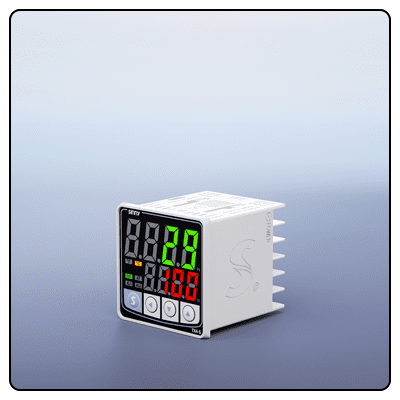What Is a Temperature Controller: Types, Sensors, Outputs and Applications
Explore what precisely a temperature controller is, its types, sensor compatibility, output type options, and advanced features and applications in various settings. Learn about their precise regulation to provide accurate temperature regulation across numerous environments.
1. Introduction
Temperature controllers are essential devices used in numerous industries to maintain and regulate precise temperature levels within specified ranges. They make processes run more smoothly and efficiently by keeping conditions constant within specific parameters. This article introduces a temperature controller, its types, sensor compatibility issues, output options available as output types, and advanced features and their applications.
2. Definition and Function
Definition:
A temperature controller is an electronic device which accepts input from a temperature sensor and compares it against an appropriate setpoint to deliver output to control elements that maintain desired temperatures. A typical controller consists of three main parts - sensor, controller unit, and output device - but many manufacturers now also make standalone temperature regulators that work like this.
Function:
A temperature controller serves many vital purposes in various applications; most importantly to achieve desired temperatures by controlling heating or cooling elements accordingly. A manufacturing plant employing this tool must process materials at specific temperatures to produce the desired properties in finished goods. At the same time, in laboratories, it helps ensure ideal incubator conditions for experiments.
3. Different Types of Temperature Controllers
On/Off Controllers:
On/Off controllers are among the simplest types of temperature regulators, providing essential on/off functionality that maintains desired temperatures by switching output entirely on or off to maintain desired levels. They're suitable for applications where precise control over temperatures is not a top priority, such as household appliances such as ovens and refrigerators.
Proportional Controllers: Proportional controllers provide more precise temperature regulation than On/Off controllers by adjusting output proportionally to any differences between setpoint and actual temperatures, providing accurate temperature regulation in applications like HVAC. They're great for maintaining constant temperatures - like HVAC.
PID Controllers:
PID (Proportional-Integral-Derivative) Controllers combine proportional, integral, and derivative adjustments for precise control in applications requiring high accuracy and stability - such as chemical processing or laboratory environments requiring precision. PID controllers continuously calculate error values before making necessary output changes to minimize error values as part of their output control strategy.
4. Sensor Compatibility
Types of Sensors:
* Thermocouples: These thermometers are widely utilized due to their wide temperature range and fast response time - ideal for high-temperature applications.
* RTDs (Resistance Temperature Detectors): RTDs offer accurate temperature measurements with pinpoint precision, making them the go-to solution in applications needing precise temp measurements.
* Thermistors: These sensors are exceptionally responsive to temperature variations and are often used when fast response times are essential.
Integrity of Compatibility:
Selecting a temperature controller compatible with the sensors you plan to use is critical regarding the accuracy and reliability of temperature measurements; using RTD sensors with compatible controllers provides superior precision during temperature-sensitive processes such as manufacturing.
5. Output Types
Electromechanical Relays:
These relays can quickly switch high-power loads but have limited lifespan due to mechanical wear; as such, they're most often employed where the switching frequency is low.
Solid State Relays (SSRs): SSRs offer increased lifecycles and faster switching times compared to electromechanical relays, making them perfect for applications such as industrial heating systems.
Analog Outputs:
Analog outputs provide continuous signals with variable control capabilities for applications like heating elements. With precise control over their production and fine adjustments available when needed, analog outputs make an ideal solution in applications requiring precise management and precise adjustments of output levels.
6. Advanced Features
Autotuning: Autotuning automatically optimizes PID parameters by optimal conditions for maximum effectiveness for simplified setup and efficient controller performance. This feature expedites setup time while guaranteeing peak efficiency from every controller.
Adaptive Control: This form of real-time regulation changes control parameters based on process changes to ensure stable temperatures even in dynamic environments. This feature increases controller performance.
Remote Monitoring: This feature enables users to remotely monitor and control temperature controllers in hard-to-reach places, providing greater convenience.
7. Applications for Temperature Controllers
Temperature Controller Applications in Industrial Applications: Temperature controllers have multiple industrial uses, from manufacturing to chemical processing and food production. In these instances, maintaining precise temperatures is vital in order to guarantee product quality and process efficiency; for example, in chemical processing, temperature regulators regulate reactor temperatures to create optimal reaction conditions.
Commercial Applications:
Temperature controllers have become integral to HVAC systems and food processing facilities to help create comfortable indoor temperatures while assuring food safety and quality. They're also helpful in controlling oven and refrigeration unit temperatures, ensuring food safety and quality are met.
Consumer Applications:
Temperature controllers are commonly utilized in home appliances like ovens, refrigerators, and air conditioners to achieve ideal temperatures for safe living environments. Climate control systems also utilize temperature controls to create comfortable living environments for residents.
8. Conclusion
Temperature controllers are essential devices that ensure precise temperature regulation across various applications. By understanding their multiple types, sensor compatibilities, output types, advanced features, and applications - you can make an informed choice when choosing one for yourself or an application you use regularly. Regular maintenance and setup must occur to guarantee the optimal temperature controller performance.
- Benefits of Implementing a Temperature Control System: Enhancing Quality, Efficiency, and Safety
- What is a Temperature Control System and Why Do You Need It























